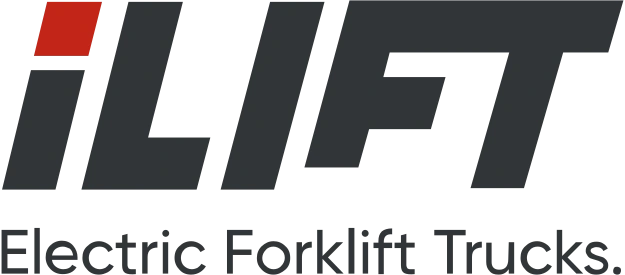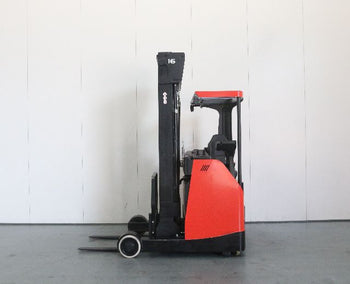Narrow aisles are an effective way to boost storage density, but they demand a specialised forklift. A narrow aisle reach truck is designed to operate where a counterbalance forklift cannot. Instead of relying on a rear counterweight, reach trucks use a pantograph and stabilising legs so the overall body length is shorter. This enables them to work in aisles as narrow as 2.5–3 m (about 8 ft) compared with 3.5–4.5 m needed by a counterbalance forklift. By switching to reach trucks, warehouses can gain 20–30 % more pallet positions and in some cases improve storage density by as much as 40 %.
Unlike typical forklifts that lift straight up, reach trucks extend their forks into the rack while the body remains in the aisle. Modern electric reach trucks are quiet, emission‑free and suited to indoor environments. They are available for hire or purchase from iLift in a range of capacities and configurations designed for narrow aisle reach truck operations.
Why narrow aisles require reach trucks
Space optimisation
Space is a scarce resource in warehouses. Reach trucks excel at utilising both floor area and vertical space. Their compact chassis and specialised steering systems allow them to manoeuvre in tight aisles. Because the truck body doesn’t need to turn into the rack, aisles can be reduced to 8–10 feet or even 2.5 m. A narrow aisle configuration can yield up to a 40 % increase in storage capacity, freeing up valuable floor space and reducing the need for costly expansion.
Vertical reach is another advantage. Standard reach trucks can lift loads to 8–12 m (26–40 ft) and some models exceed this. The ability to access high‑bay racking means warehouses can make full use of vertical volume, especially in facilities with high rental costs or limited land availability.
Efficiency and productivity
Reach trucks speed up picking and put‑away tasks by reducing travel distance. Because the operator can extend the forks into the rack, they do not need to reposition the entire truck each time. Telescopic forks and adjustable fork positions enable reach trucks to handle various pallet sizes and double‑deep racking without moving the first pallet. This reduces cycle times and increases throughput. In comparison, counterbalance forklifts require more aisle space and cannot reach as high..
Reach trucks are almost always battery‑powered. Lithium‑ion technology offers fast charging, opportunity charging during breaks and reduced maintenance. iLift’s EP CQD16/20L reach truck is built around lithium‑ion technology and provides precise stacking, quiet operation and high stability. Its compact structure makes it suitable for wide or narrow‑aisle racking settings, and capacities of 1.6–2 tonnes with lift heights of 6.5–9 m make it ideal for medium‑to‑large warehouses.

Safety advantages
Operating in confined spaces carries risk, so reach trucks incorporate advanced safety technologies. Many models feature sensors, cameras and automatic braking systems to reduce collisions. Electric trucks emit less vibration and noise, improving operator comfort and reducing fatigue. The side‑facing operating position common on reach trucks gives operators good visibility down the aisle, although the mast can obstruct forward view. To mitigate this, modern reach trucks use ergonomic controls and fingertip joysticks for precise manoeuvring.
Key features to look for in narrow aisle reach trucks
Compact chassis and pantograph
A short chassis and narrow wheelbase are essential for navigating tight aisles. Reach trucks replace the heavy counterweight found on conventional forklifts with two stabilising legs. A pantograph mechanism allows the forks to extend into the pallet while the base legs remain stationary. Look for trucks that can operate in 2.5–3 m aisles and turn 90 degrees within the aisle. These traits minimise the turning circle and maximise pallet positions.
Telescopic and adjustable forks
Versatility is vital when handling various pallet sizes. Narrow aisle reach trucks often feature telescopic forks that extend to access loads on both sides of the aisle. Adjustable fork positions let operators handle different pallet widths without repositioning. For double‑deep racking, a pantograph or extended reach is indispensable.
When evaluating equipment, consider maximum lift height, outreach and load capacity. The CQD16/20L from iLift offers capacities up to 2 tonnes and lift heights of 6.5–9 m, making it suitable for most high‑bay applications.
Lithium‑ion battery technology
Lithium‑ion batteries deliver several benefits over traditional lead‑acid units.
They provide faster charging times, longer run‑time and opportunity charging.
There is no need for separate battery charging rooms or swap‑out sessions, so operators can recharge during breaks. Lithium‑ion forklifts generate zero emissions and require less maintenance. On iLift’s reach trucks, the 5‑year battery warranty covers defects and ensures reliable performance. Service contracts are available to minimise downtime and extend the life of your equipment.
Ergonomic operator compartment
Operator comfort is directly linked to productivity.
Manufacturers are focusing on ergonomics by offering adjustable seats, climate‑controlled cabins, intuitive control layouts and improved visibility. Reach trucks typically have sideways standing or sitting positions with steering wheel, joystick and a dead‑man pedal. Ensure the truck you select provides enough space, clear sight lines, anti‑fatigue flooring and easy‑to‑reach controls. Modern iLift reach trucks place controls strategically for comfortable operation and allow operators to stand in a stable position when storing and retrieving loads.
Integration with warehouse systems
To maximise efficiency, reach trucks should integrate with warehouse management systems (WMS). Modern models can include onboard computers and RFID technology for real‑time tracking. Integrating the truck’s location and inventory data into your WMS optimises pick routes and provides valuable analytics for performance improvements. If you are evaluating new equipment, consider models that offer connectivity or can be retrofitted with telematics.
Best practices for narrow aisle operations
Assess and reconfigure layout
Before investing in reach trucks, evaluate your current warehouse layout. Consider product types, pallet sizes, racking systems and traffic patterns. Engage with layout specialists to design an optimised floor plan that maximises storage capacity and maintains safe movement. You may need to adjust aisle widths, convert some aisles to double‑deep racking or redesign pick paths.
Plan routes and enforce traffic rules
Operating in narrow aisles requires careful planning. Designate one‑way aisles where possible and use floor markings and mirrors at aisle ends to improve visibility. Implement pedestrian warning systems, such as audible alarms and strobe lights, to alert workers when trucks are in motion. Establish speed limits and enforce rules to prevent congestion and accidents.
Train operators thoroughly
Proper training is essential for safe and efficient narrow aisle operations. Reach trucks fall under UK HSE category D1 (standard reach) or D2 (stacking above 8 m). Operators must complete accredited training and certification for the specific truck type and capacity. Skills from counterbalance trucks do not automatically transfer, because reach trucks use different controls and have different centre‑of‑gravity characteristics. Novice training typically lasts three to five days and covers safe manoeuvring, load handling, stability, use of the pantograph and emergency procedures.
Continued training and refresher courses are equally important. Refresher training should emphasise advanced controls, safe operating speeds, awareness of blind spots and proper docking at high levels. Rob’s Forklift emphasises that certification programs increase operator confidence, improve safety compliance and boost job performance.
Hands‑on training ensures operators understand how to operate different models, increasing versatility and efficiency.

Maintain equipment consistently
Maintenance is critical to ensure safety and prolong the life of your reach truck. Daily inspections should check tyres, brakes, hydraulics and other components. Follow the manufacturer’s recommended service schedule. Keep trucks clean to prevent debris build‑up, and monitor battery condition and charge levels. Proper maintenance minimises downtime and ensures consistent performance. iLift offers service contracts and pre‑delivery inspections to ensure your equipment is delivered tested and ready for use.
Prioritise safety and compliance
Narrow aisle operations leave little room for error. Invest in equipment with advanced safety features such as automatic braking, stability controls, sensors and cameras. Ensure your warehouse meets regulatory requirements and update training as regulations change. Promote a safety culture by involving operators in hazard identification and reporting near‑miss incidents. Regularly review risk assessments and update floor markings and signage as needed.
iLift’s reach truck range is designed for operator safety and includes features such as stable standing platforms and strategically positioned controls. For tailored advice on safe narrow aisle configurations, contact iLift’s experts to discuss your needs.
Selecting the right reach truck for your warehouse
Evaluate aisle width and layout
Aisle width is often the deciding factor between a reach truck and a counterbalance forklift. If your aisles are 2.5–3 m, a reach truck is the obvious choice. Counterbalance trucks need at least 3.5 m to turn safely. Consider converting wider aisles to narrow aisles and adopting reach trucks to increase pallet positions.
Consider load type and weight
Reach trucks generally handle 1–2.5 tonne palletised loads. They sacrifice some capacity for height; heavy or oversized items may require a counterbalance forklift. Assess your typical load size and shape, and choose a reach truck with an appropriate capacity and fork design.
Identify height requirements
If your racking extends beyond 8 m, a reach truck’s ability to lift to 8–12 m or more is indispensable. For lower racks (4–7 m), a counterbalance forklift might suffice. When planning for future vertical expansion, consider the maximum lift height of your equipment.
Assess operating environment
Reach trucks are designed for smooth, indoor floors. If your operations require crossing thresholds, loading lorries or working on uneven ground, an electric or diesel counterbalance forklift may be better suited. For clean indoor warehouses, reach trucks’ zero‑emission operation and low noise make them ideal.
Budget and total cost of ownership
Reach trucks have higher purchase prices than some counterbalance forklifts, especially when powered by lithium‑ion batteries. However, lower energy costs, reduced maintenance and improved efficiency often result in a quick return on investment. Evaluate not just the upfront cost but also savings from decreased aisle width, reduced labour time and lower downtime.
Conclusion: unlocking narrow aisle efficiency with iLift
Narrow aisles present challenges, but with the right equipment and practices they become an opportunity to maximise storage density and streamline operations.
Narrow aisle reach trucks allow aisles as tight as 2.5–3 m, provide high lift heights and improve productivity through telescopic forks and advanced controls.
Proper operator training and regular maintenance are essential to harness these benefits safely.
iLift specialises in lithium‑powered reach trucks and offers models like the EP CQD16/20L with capacities up to 2 tonnes and lift heights of 9 m. These units deliver quiet, emission‑free performance with fast‑charging batteries and come with pre‑delivery inspections, service contracts and a 5‑year battery warranty. Whether you need a single truck or a fleet, iLift’s team can advise on layout optimisation, operator training and equipment selection. By implementing narrow aisle reach trucks and following best practices, warehouses can dramatically improve storage capacity, worker safety and overall efficiency—unlocking new potential in every square metre.



